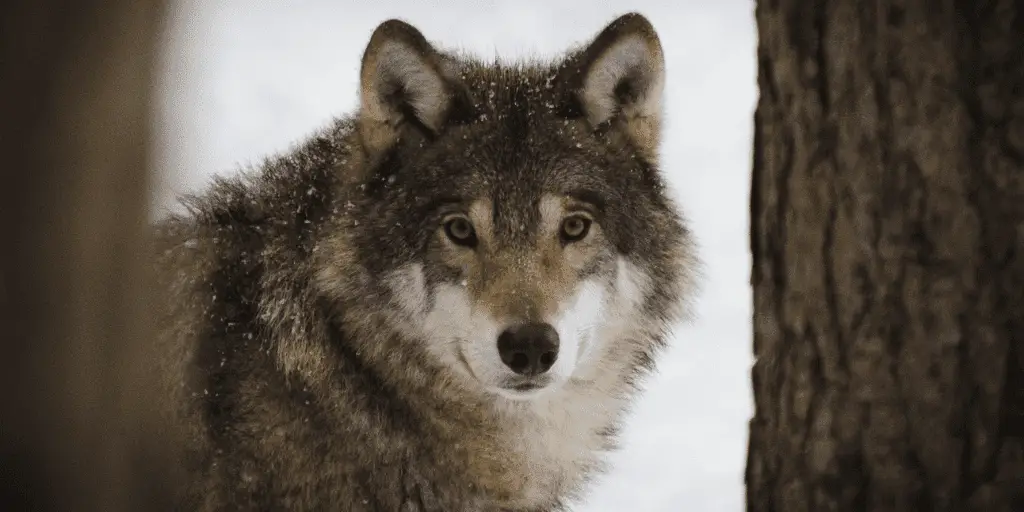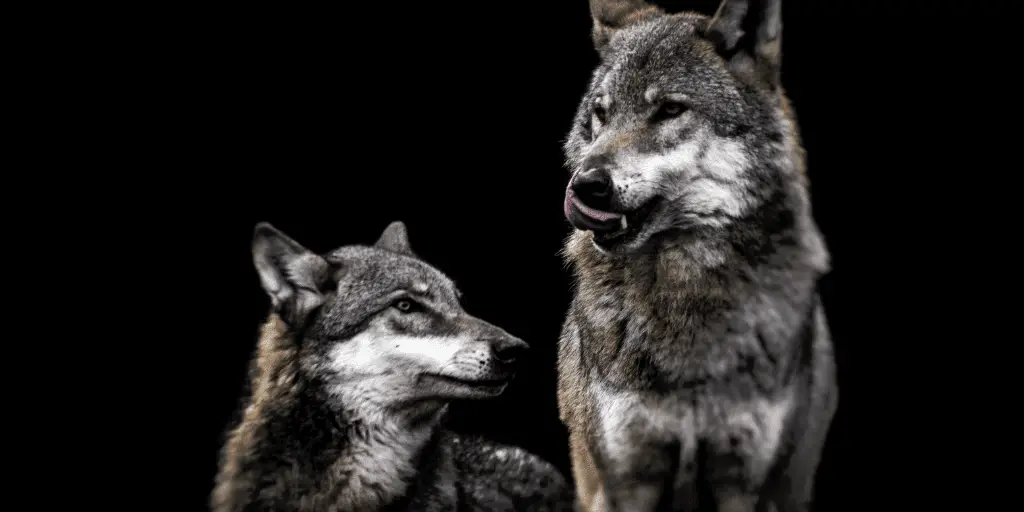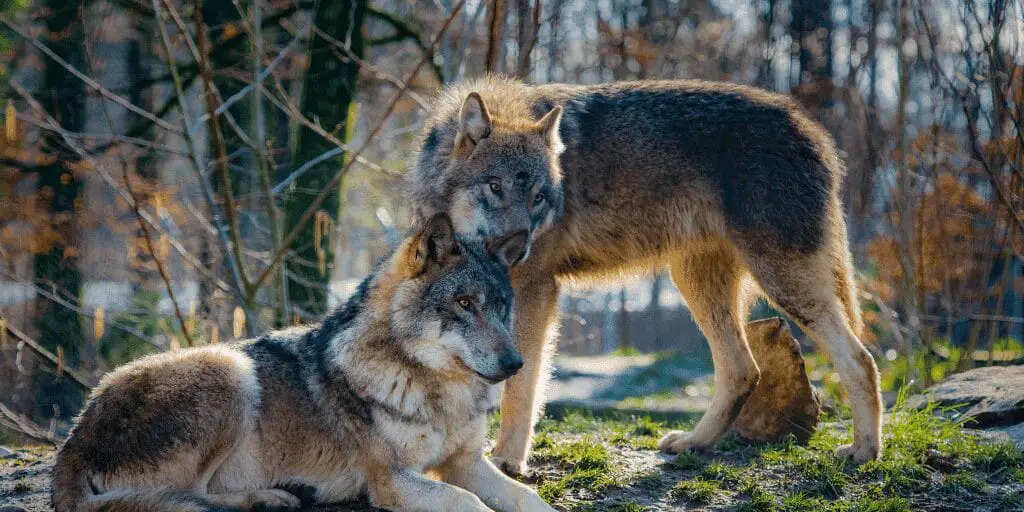Venture into the twilight realm of wolves, where their extraordinary night vision reigns supreme. Essential for survival, this remarkable ability allows them to hunt with precision and navigate the dark with ease. Discover the evolutionary marvels behind their luminous eyes and how they compare to our own human sight.
Key Takeaways:
- Wolves have evolved to have excellent night vision, with large pupils and a high proportion of rod cells in their eyes, which are sensitive to low light levels, allowing them to detect movement and shapes in the dark.
- The presence of the tapetum lucidum in wolves’ eyes, a layer that reflects light back through the retina, significantly enhances their ability to see in low-light conditions and is responsible for the characteristic eyeshine when light hits their eyes at night.
- Wolves’ night vision is a result of both anatomical adaptations, such as the structure of their eyes, and the efficient neurological processing of visual information, enabling them to navigate and hunt effectively in the dark.
- The evolutionary development of wolves’ night vision has been driven by survival, with natural selection favoring those with better nocturnal capabilities, which has been crucial for hunting and territory defense.
- While wolves have superior night vision compared to domestic dogs, both species have a similar color perception, with a tendency towards blue and yellow hues, and a reduced ability to distinguish red and green.
Can Wolves See in the Dark?
Wolves have evolved to see in the dark with large pupils, a high proportion of rod cells, and a reflective layer called the tapetum lucidum.
| Feature | Description | Evolutionary Significance |
| Large Pupils | Wolves possess large pupils that expand to let in maximum light during low-light conditions. | Allows wolves to hunt and navigate effectively at night or during dusk and dawn, crucial for their survival and predatory efficiency. |
| Rod Cells Dominance | Their retinas have a high proportion of rod cells, which are more sensitive to light than cone cells, enabling them to detect movement and shapes in near-darkness. | Facilitates superior night vision, essential for tracking prey and avoiding predators in their nocturnal activities. |
| Tapetum Lucidum | A reflective layer behind the retina, the tapetum lucidum, enhances their ability to see in low light by reflecting light back through the retina. | Provides an evolutionary advantage in nocturnal hunting and territory defense, contributing to their success as apex predators. |
| Color Perception | While possessing superior night vision, wolves have a color perception leaning towards blue and yellow hues, with reduced ability to distinguish red and green. | Indicates an evolutionary trade-off, prioritizing night vision over color differentiation, which is less critical in nocturnal and crepuscular settings. |
| Evolutionary Adaptation | The development of wolves’ night vision is a result of natural selection, favoring individuals with better nocturnal capabilities for survival. | Highlights the evolutionary pressures that shaped wolves into effective nocturnal hunters, ensuring their success in various ecosystems. |
| Comparison with Humans and Dogs | Wolves have superior night vision compared to humans and even domestic dogs, showcasing their specialized adaptations for life in the wild. | Emphasizes the evolutionary divergence between wolves, humans, and domestic dogs, with each species developing visual capabilities suited to their environmental and lifestyle needs. |
| Ecological Impact | Wolves’ night vision contributes to their role in maintaining ecological balances through their hunting practices and territorial behaviors. | Underlines the importance of wolves in natural ecosystems, showcasing how evolutionary traits like night vision contribute to broader ecological functions and biodiversity. |
Understanding Wolves’ Vision

Wolves are often associated with the mystique of the night, moving through the darkness with ease. But what is it about their vision that allows them to navigate the nocturnal world so effectively? It’s not just a matter of being able to see in the dark; wolves have evolved a set of unique visual tools that give them an edge when the sun goes down.
Anatomy of a Wolf’s Eye
Imagine having the ability to see the world through a wolf’s eyes. Their eyes are marvels of evolution, fine-tuned for optimal performance in low-light conditions. One of the most noticeable differences when you look into a wolf’s eye is the large pupil. This isn’t just for show; a larger pupil can open wider than a human’s, allowing more light to enter the eye, which is crucial for night vision.
But it’s not just about size. Inside the eye, wolves have a higher proportion of rod cells to cone cells compared to humans. Rod cells are the champions of dim light vision, sensitive enough to respond to even the faintest light. This means that even under the cover of night, wolves can detect movement and shapes, which is essential for tracking prey.
Then there’s the tapetum lucidum, a feature humans lack. This layer acts like a biological mirror, reflecting light that passes through the retina back into the eye, giving the rods another chance to absorb the light. This is why wolf eyes seem to glow when caught in a beam of light at night – it’s the tapetum lucidum at work.
Role of Rod Cells in Night Vision
Diving deeper into the wolf’s retina, the role of rod cells cannot be overstated. These cells contain the photopigment rhodopsin, which is incredibly sensitive to light. When light hits rhodopsin, a chemical reaction occurs that sends a signal to the brain, creating an image. In wolves, this system is highly efficient, allowing them to pick up on subtle movements and silhouettes in the dark that would be invisible to humans.
This heightened sensitivity is a testament to the wolf’s evolutionary journey. As nocturnal hunters, having a retinal composition that favors rod cells over cone cells means that wolves can hunt with precision in conditions that would leave other animals stumbling in the dark.
Tapetum Lucidum: A Mirror in the Dark
The tapetum lucidum is a fascinating aspect of the wolf’s eye. This structure is like a secret weapon, doubling the chances of light hitting the photoreceptors. It’s made of layers of cells containing crystals that reflect light. This not only improves night vision but also contributes to the eerie eyeshine observed when light hits these animals’ eyes at night.
The evolutionary origins of the tapetum lucidum are a testament to the survival advantage it provides. In the arms race of predator and prey, being able to see in the dark is a significant edge. For wolves, this means they can operate under the cloak of darkness, using their enhanced visual acuity to track down prey that is less equipped to see in the dark.
By understanding the anatomy and physiology of wolves’ eyes, it becomes clear how these animals have become such proficient nocturnal hunters. Their eyes are not just adapted to the dark; they are optimized for it, allowing wolves to thrive in environments where others merely survive.
The Science Behind Night Vision in Wolves

Photoreceptor Optimization for Low Light
Imagine your eyes are like a camera. In wolves, this camera is specially designed for low-light photography. The retina, which works like the camera’s film, is packed with cells called photoreceptors.
Wolves have an abundance of rod cells, the photoreceptors that are incredibly sensitive to light, even when there’s hardly any. These rods are like tiny biological night-vision goggles, capturing every possible photon of light. And while wolves have fewer cone cells, which are responsible for color vision, they’re still adept at detecting movement and subtle shades, crucial for spotting prey or danger in the twilight.
The biochemical makeup of these rod cells is a marvel. They contain a pigment called rhodopsin, which is incredibly responsive to low light levels. When even the faintest light touches these cells, a chemical reaction occurs, allowing wolves to effectively see in conditions that would leave us blind. This rapid response to changing light is like having an automatic brightness adjuster, giving wolves a visual edge in the dark.
Neurological Processing of Visual Information
But seeing in the dark isn’t just about having the right cells in the eyes. It’s also about the speed and efficiency with which visual information is processed. For wolves, this happens lightning-fast. The optic nerve serves as a high-speed data cable, transmitting signals from the eye to the brain. Once there, the visual centers are fine-tuned for interpreting these low-light scenes.
Wolves’ brains are wired to make sense of the dark world around them with astonishing accuracy. This neurological prowess means they can make quick decisions during a night hunt, or navigate complex terrain without hesitation. It’s a sophisticated system that’s been honed over countless generations, making wolves as comfortable under the moon as we are under the sun.
Evolutionary Development of Night Vision
The story of how wolves came to possess such incredible night vision is a tale of survival. Over millennia, the wolves that could see better in the dark were more successful hunters and were less likely to fall prey to other nocturnal predators. These wolves passed their genes on, leading to a lineage of canines with ever-improving night vision.
This evolutionary journey was driven by the need to thrive in the night. The wolves that could see a rabbit’s twitch from afar or detect the silent swoop of an owl had a distinct advantage. As the generations passed, natural selection favored those with superior night vision, sculpting the wolf’s eyes into the perfect instruments for nocturnal life. It’s a testament to the power of evolution and the constant dance between predator, prey, and environment.
Comparison of Night Vision Among Animals
Wolves vs. Owls: Masters of the Night
Imagine a world bathed in the pale glow of moonlight, where every shadow could conceal prey—or a predator. In this dim environment, wolves and owls reign supreme, but their tools of trade differ vastly.
Owls are equipped with large, forward-facing eyes, their pupils capable of dilating to impressive sizes to capture every sliver of light. The density of rod cells in their retinas is extraordinary, providing them with remarkable sensitivity to light. Additionally, a mirror-like layer called the tapetum lucidum sits behind the owl’s retinas, reflecting light back through the eyes and enhancing their night vision.
Wolves, on the other hand, may not match the owls’ binocular magnificence, but their eyes are no less adapted to the dark. Their pupils also expand to let in more light, and they too have a tapetum lucidum, which gives their eyes a characteristic eyeshine when illuminated.
While they may not see in the same detail as owls, wolves have a wider field of view and excellent motion detection, which serve them well in the chase. Each species’ hunting strategy plays to its visual strengths—owls dive silently from the sky, while wolves pursue their prey with endurance and teamwork.
The Spectrum of Animal Vision
The animal kingdom is a tapestry woven with a myriad of visual systems, each tailored to the demands of its environment. Some creatures, like the deep-sea fish, dwell in perpetual darkness, their eyes adapted to detect the faintest glimmers of light. Others, like the mantis shrimp, perceive a spectrum of color beyond our human capacity, their eyes segmented into a mosaic of lenses.
Nocturnal animals often sacrifice color vision for sensitivity, their eyes rich with rod cells that excel in low-light conditions. Diurnal creatures, like us humans, boast a higher proportion of cone cells, granting us the vibrant panorama of color that we enjoy under the sun. This trade-off between light sensitivity and color perception is a hallmark of evolutionary compromise, each species finding its balance to thrive in its niche.
Human Vision in Contrast
In the realm of night vision, humans are not the most adept. Our eyes, while capable of adjusting to lower light levels, lack the tapetum lucidum that gives many animals their luminous gaze in the dark. Our color vision, while rich by day, fades as the light dims, and our visual acuity drops significantly. We’ve turned to technology—flashlights, night-vision goggles, and more—to extend our sight into the night.
Our evolutionary path as diurnal beings has shaped our eyes to prioritize color and detail over the ability to see in the dark. The human field of view is wide, but not as expansive as that of a wolf, whose eyes are set more to the side of their head.
This difference in anatomy reflects our respective survival strategies: humans as gatherers and hunters by daylight, wolves as pack hunters that excel in the twilight hours. By understanding the contrasts and similarities between human and wolf vision, we gain insight into the remarkable adaptability of the eyes and the diverse ways in which life has evolved to meet the challenge of darkness.
Evolutionary Advantages of Night Vision
Enhancing Hunting Efficiency
When the sun sets, the world doesn’t go to sleep—especially not for wolves. Their night vision is like a secret weapon that turns the cover of darkness into an ally. Imagine being able to spot a hare zigzagging through the underbrush or a deer grazing in a moonlit clearing, all while your prey is none the wiser. Wolves can do just that, thanks to their exceptional ability to see in low light.
This isn’t just about having a late-night snack; it’s about survival. Wolves target various nocturnal and crepuscular creatures that other predators might miss. They employ stealth and strategic coordination that’s only possible with sharp night vision. Pack members can signal each other with subtle gestures, almost like a group of commandos on a covert operation, ensuring they work together seamlessly to outsmart their prey.
Social and Territorial Advantages
But life isn’t all about the hunt. Wolves are social animals with complex relationships and a need for a well-defined territory. Night vision plays a pivotal role here too. It allows them to recognize each other during nighttime rendezvous and stay alert to any intruders trying to sneak into their domain under the cover of darkness.
Territory is everything for a wolf pack—it’s where they live, hunt, and raise their young. Being able to patrol and defend this territory at night is crucial. It’s during these nocturnal hours that wolves can encounter rivals and other threats. With their night vision, they can effectively manage these encounters and maintain the delicate balance of their social order.
Adaptation to Diverse Ecosystems
Wolves don’t just stick to one type of neighborhood; they’re found in a variety of ecosystems across the globe. Their night vision has been a key player in this adaptability. Whether it’s threading through dense forests without a stumble or navigating the stark, open landscapes of the arctic tundra, wolves can do it all.
This adaptability isn’t just impressive; it’s essential for the health of these ecosystems. As apex predators, wolves play a critical role in controlling prey populations and maintaining biodiversity. Their presence can shape entire landscapes, a phenomenon known as a trophic cascade. Night vision, therefore, isn’t just about seeing in the dark—it’s about maintaining the delicate balance of life across our planet’s diverse habitats.
Wolves’ Vision Compared to Domestic Dogs

Night Vision in Dogs vs. Wolves
Let’s talk about night vision, which is like having a built-in pair of night goggles. Wolves are the champions here. Their eyes have evolved for life in the wild, with a special layer called the tapetum lucidum that acts like a mirror, reflecting light through their retinas twice.
This gives them a big advantage when the sun goes down. Dogs have this too, but it’s not quite as shiny as their wolf cousins’. Plus, wolves have more rod cells, which are like tiny night vision sensors, compared to dogs. This means wolves can see better in the dark, which is super handy for hunting at dusk or dawn.
Now, because dogs have been hanging out with humans for so long, their eyes have changed. They don’t need to rely on night vision as much as wolves do. This has led to a trade-off, where some breeds of dogs might not see as well at night but are better at picking up on human cues, like hand signals, even in low light.
Color Perception and Visual Acuity
Moving on to colors and clarity, wolves and dogs see the world differently. Wolves’ color vision is similar to a human with red-green color blindness. They’re great at picking up blues and yellows, but reds and greens? Not so much.
Dogs are in the same boat, but their vision isn’t quite as sharp as wolves’. This is because wolves need to spot the slightest movements or changes in the landscape when they’re hunting, while dogs rely more on their sense of smell and hearing to get by.
The reason behind these differences is all about lifestyle. Wolves need to be sharp-eyed hunters, while dogs have adapted to a life with humans, where those eagle eyes aren’t as critical.
Behavioral Implications of Visual Differences
These differences in eyesight have a big impact on how wolves and dogs behave. Wolves, with their superior night vision, are more confident roaming and hunting in low light. Dogs, on the other hand, might be a bit more hesitant when the lights go out, but they’re champs at following visual commands from their human friends.
For domestic dogs, these visual differences can affect how well they do in activities that need good eyesight, like herding sheep or running through an agility course. Some breeds, like border collies, still have pretty good vision and can spot a frisbee from across the park, while others might be better off sniffing out treats than catching them mid-air.
By understanding these visual capabilities, we get a glimpse into how wolves and dogs have adapted to their worlds—one wild and one by our side.
Myths and Misconceptions About Wolves’ Night Vision
Debunking Popular Myths
One common myth is that wolves possess the supernatural ability to see perfectly in total darkness. However, like all mammals, wolves need at least a sliver of light to see. While their vision is indeed superior in dim conditions compared to humans, it’s not infallible.
Another tall tale is the notion that wolves’ eyes can emit light. In reality, no animal’s eyes, including those of wolves, produce their own light. Instead, what people often mistake for a wolf’s eyes emitting light is a reflection caused by a special layer in their eyes, which we’ll explore in more detail shortly.
The fascination with wolves’ supposed mystical powers reflects our deep-seated curiosity about the natural world and the creatures that inhabit it.
The Truth About Wolves’ Eyes Glowing in the Dark
The eerie glow of wolves’ eyes in the dark is not a product of fantasy but a biological marvel known as eye shine. This is thanks to the tapetum lucidum, a reflective layer behind the retina that enhances light available to photoreceptors, improving night vision.
The color of this eye shine can vary and is often misconstrued as a sign of mood or health, but in truth, it’s simply a matter of light and angles. Understanding this physiological trait demystifies wolves’ night vision and showcases an incredible adaptation to their nocturnal lifestyle.
Impact of Myths on Wolf Conservation
Misconceptions about wolves, including those about their night vision, can have real-world consequences. When wolves are portrayed as almost supernatural beings with glowing eyes and the power to see in pitch darkness, it can feed into fear and misunderstanding.
Such myths may cast these animals as villains in the night, potentially impeding conservation efforts. On the flip side, accurate knowledge about wolves can lead to admiration and respect, underlining their importance in maintaining healthy ecosystems.
Education plays a pivotal role in conservation, and dispelling myths is a crucial step toward ensuring wolves are seen not as mythical creatures of the night but as essential, living parts of our natural world.
Conclusion
In conclusion, wolves possess remarkable night vision that allows them to navigate and hunt effectively in low-light conditions. Their large pupils, high proportion of rod cells, and the presence of the tapetum lucidum contribute to their ability to see in the dark. While not supernatural, their night vision is a product of evolutionary adaptation, honed over millennia to give them an edge as nocturnal hunters.
Wolves’ eyes are optimized for detecting movement and shapes, crucial for tracking prey, and their brains are adept at processing visual information quickly. Comparatively, wolves have better night vision than domestic dogs and humans, reflecting their different evolutionary paths and survival needs.
Understanding the science behind wolves’ night vision dispels myths and highlights the evolutionary marvels of these apex predators, emphasizing the importance of their role in various ecosystems and the need for their conservation.








